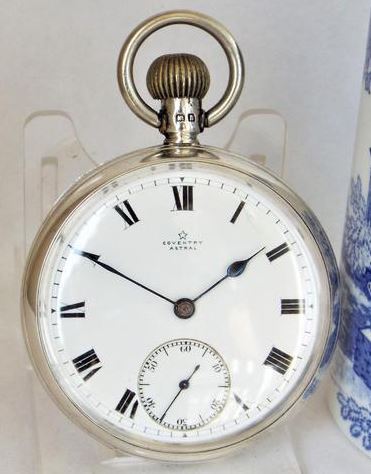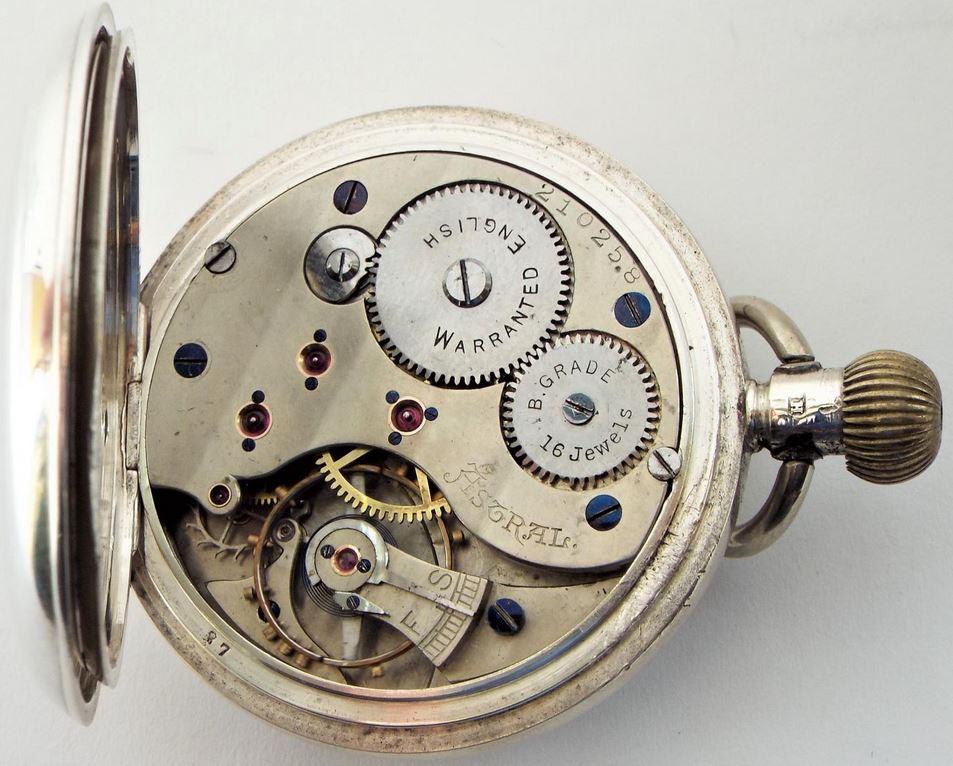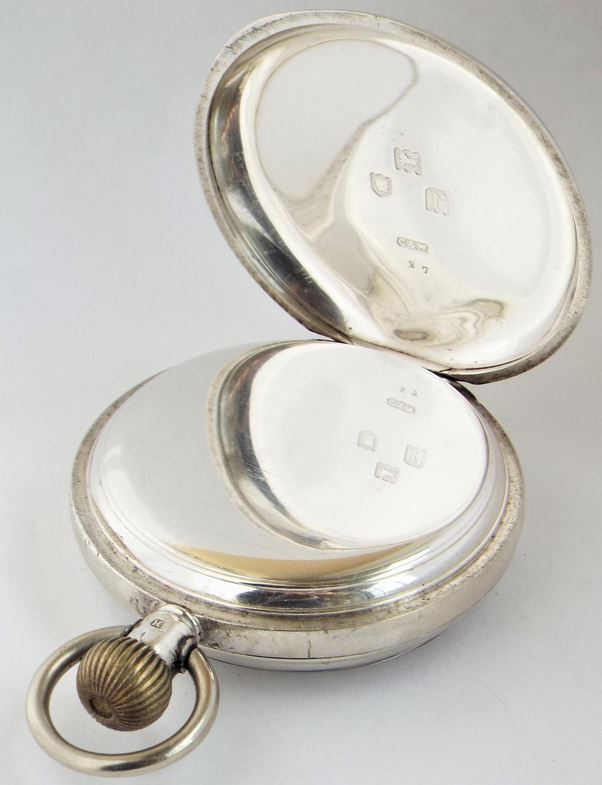Last updated on July 2, 2024
I am always looking for something new and different to add to my collection of antique watches. I enjoy researching my antique timepieces as much as wearing them. As I was researching this antique Coventry Astral pocket watch I was also looking at another antique pocket watch by Wright & Craighead. The watches in my collection need to be presentable and reliable. I expect my antique watches to be accurate to within a minute over 12 hours.
Sometimes the research becomes my downfall as the watch may be sold before I complete my investigation. In this instance, I was lucky. In the week it took to complete my research, the watch was still available for sale. It arrived today and is sitting ticking, loudly, at my desk as I type. What attracted me to this antique Coventry Astral pocket watch, was the manufacturer/maker, H Williamson Ltd and the fact that it had an unusual, at least in my experience, movement with 16-jewels.
H Williamson Ltd
H Williamson Ltd was founded by Henry Williamson (c.1844-1914) in either 1865 or 1871. According to the census records of 1871, Henry was living in London with his wife and three children. His occupation was listed as ‘Jet ornament maker’. Jet is a hard-black fossilized wood that can be carved and highly polished. Queen Victoria wore Jet gemstones as part of her mourning dress after the death of Prince Albert in 1861. As a result, jet ornaments became extremely fashionable. When Jet eventually went out of fashion in the 1880s the company was forced to diversify into other areas. The 1891 census shows that the Williamson family had moved to Hove, Sussex. Henry’s occupation was now listed as a wholesale jeweller.
Watch factory
At some point in the 1890s, Henry started retailing watches along with silverware. In 1895, Henry purchased the Errington watch factory, which had been established in Coventry in the 1880s by Charles Hutton Errington. Errington is recorded as a watch movement maker in 1892, obtaining rough movements to finish into watches. In 1896, Henry bought the remnants of the English Watch Company, including the machinery to make both front and backplates. This meant he was in a position to manufacture and finish his own watches.

Swiss factory
In 1898 the firm took control of a Swiss watchmaking factory in Buren. Henry was now casing Swiss movements in English made cases. Unfortunately, just one year later, Williamson was found guilty of selling the watches as being entirely made in England. As a result, Henry was fined and had the watches confiscated. To get around this issue, Henry imported Swiss machinery into his Coventry factory. This allowed him to produce Warranted English watches with Swiss characteristics including a straight-line lever escapement.
The 1901 census shows that the Williamson family was back living in London. Henry’s occupation was now listed as ‘Managing Director of a watch manufacturer”. Around 1911, suffering from declining health and deteriorating eyesight, Henry retired to Hove, Sussex. His son, Charles and another employee, William Tucker, were appointed as managing directors. Henry died in 1914.
Trench watches
During the First World War, H. Williamson Ltd was one of the first companies to capitalise on the new trench watch. During the company’s 1916 AGM it was noted that “…the public is buying the practical things of life. Nobody can truthfully contend that the watch is a luxury. It is said that one soldier in every four wears a wristlet watch, and the other three mean to get one as soon as they can.” During WW1, Williamson Ltd produced thousands of wristwatches a week for the War effort. By the end of the war, almost all enlisted men wore a trench watch. This trend was soon adopted by the civilian population. After the war, they ventured into the world of clock making and then further diversified into gramophones. However, after a period of six consecutive years of losses and the Great Depression, the company collapsed in 1931.
Movement
The watch has a nice quality 16 jewel stem-winding movement which is working accurately. The movement is signed with the Astral name and Warranted English, 16 jewels and B grade. The movement is protected by an inner hinged cover. 16 jewel movements have a hole jewel for the centre wheel on the top plate, but do not include a corresponding jewel on the pillar plate. Typically, these movements were not marked as 16 jewels. This is because the visible top plate jewel on the centre wheel could give the impression that the movement had 17 jewels. Normally, if the movement wasn’t marked, the dial would need to be removed to confirm the jewel count. This is the first antique pocket watch I have seen that is stamped 16 jewels. I’m not sure why they didn’t bother with that one extra jewel.

Interestingly, the movement is stamped “Warranted English”. However, without this branding, it would easily be mistaken for a Swiss-made movement. It has a Swiss straight-line lever escapement and exposed winding wheels, Swiss mainspring, balance spring, balance and jewels. It is essentially a Swiss watch made in England using Swiss machinery.
Case
The watch measures 49.8mm in diameter excluding the winding stem and the loop. The case is silver and there are hallmarks inside the covers for London 1912 with a case maker’s mark for Clarke & Ward, Thomas Samuel Clarke & Alfred Ward trading as Clarke & Ward, 55 Kensington Road, Coventry. Clark & Ward registered punch marks at the London & Chester Assay Offices in June 1910. The case has a couple of slight bruises to the back cover but overall is in very acceptable condition for a 1910s piece. The bruises are hardly noticeable and add to the character of this antique watch.

The acrylic lens is in good condition. However, acrylic wasn’t invented until the 1920s and this antique watch is dated to 1912. As a result, this is obviously a replacement for the original mineral crystal. The enamel dial is signed ‘Coventry Astral’, a brand name first registered by H Williamson Ltd in 1910. The dial has a few very faint hairline cracks to the outer edge. Otherwise, it is in good condition for an antique pocket watch of this age. It also has a single-sunk seconds dial. This is generally a good indicator of a quality watch.
I am pleased with this addition to my collection. It is very presentable and keeps accurate time over twelve hours, which is very acceptable for an antique pocket watch. I will look forward to wearing this antique Coventry Astral pocket watch in the not-too-distant future. In the meantime, I will continue in my search for more interesting antique watches.

I have an open faced Coventry Astral pocket watch that I found in an old cardboard box in a drawer. I am guessing the watch could have been in that box for over 50 years. It still works remarkably well. The watch in the post is dated to 1912 based on the hallmarks inside the case. How do I open the case back? I don’t want to risk damaging the watch. It is a family heirloom, but I don’t know of its origins, knowing the date would certainly help pin down the original owner. Thanks.
Hi Denae, If you pick up your Coventry Astral pocket watch so it is facing you. The 12 marker will be directly beneath the crown/stem. At the bottom of the watch, at the 6 marker on the back of the case will be the hinge for the case back. Just to the left of the crown/stem there is a tiny little raised lip that might not be obvious to the naked eye. Use your fingernail against the lip and push back to open the case back. It should open easily without much effort. You could also use a case knife, but be careful to avoid scratches. Inside the case back will be the hallmarks, consisting of an assay office mark, a fineness mark, a sponsor’s mark and a date letter. You can use this guide on how to read British hallmarks to determine the date. To reveal the movement open the dust cover or cuvette by looking for the tiny slot that is positioned below where the outer cover lip is situated. Again, you can use a fingernail or a case knife. It should open with minimal effort. Inside you will see the movement in action. If your Coventry Astral pocket watch has been sitting in a drawer for fifty years it is definitely time to get it service. The lubricants in the watch would have dried out decades ago and you could be causing damage every time you let it run. There is a list of accredited repairers at the British Horological Institute. Other countries will have similar organisations. It is worth getting it serviced for future generations to enjoy. Typically modern lubricants last for about ten years and it is worth running the watch monthly to ensure the lubricant is evenly distributed. I hope this helps, thanks for taking the time to comment, Jason.